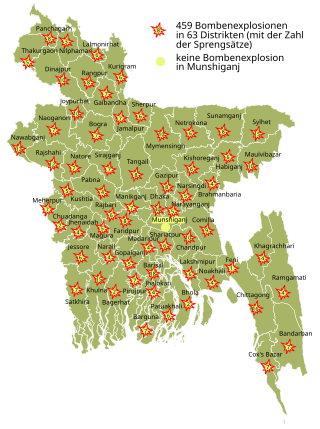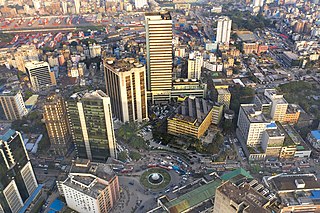Related Research Articles

Jamaat-ul-Mujahideen is a Islamist Militant Terrorist organisation operating in Bangladesh. It is listed as a terror group by Bangladesh, India, Malaysia, The United Kingdom and Australia. It was founded in April 1998 in Palampur in Dhaka Division by Abdur Rahman and gained public prominence in 2001 when bombs and documents detailing the activities of the organisation were discovered in Parbatipur in Dinajpur district. The organisation was officially declared a terrorist organisation and banned by the government of Bangladesh in February 2005 after attacks on NGOs. But it struck back in mid-August when it detonated 500 small bombs at 300 locations throughout Bangladesh. The group re-organised and has committed several public murders in 2016 in northern Bangladesh as part of a wave of attacks on secularists.
Sectarian violence in Pakistan refers to violence directed against people and places in Pakistan motivated by antagonism toward the target's religious sect. As many as 4,000 Shia are estimated to have been killed in sectarian attacks in Pakistan between 1987 and 2007, and thousands more Shia have been killed by Salafi extremists from 2008 to 2014, according to Human Rights Watch (HRW). Sunni Sufis and Barelvis have also suffered from some sectarian violence, with attacks on religious shrines killing hundreds of worshippers, and some Deobandi leaders assassinated. Pakistan minority religious groups, including Hindus, Ahmadis, and Christians, have "faced unprecedented insecurity and persecution" in at least two recent years, according to Human Rights Watch. One significant aspect of the attacks in Pakistan is that militants often target their victims places of worship during prayers or religious services in order to maximize fatalities and to "emphasize the religious dimensions of their attack".
1999 (MCMXCIX) was a common year starting on Friday of the Gregorian calendar, the 1999th year of the Common Era (CE) and Anno Domini (AD) designations, the 999th year of the 2nd millennium, the 99th year of the 20th century, and the 10th and last year of the 1990s decade.
2001 (MMI) was a common year starting on Monday of the Gregorian calendar, the 2001st year of the Common Era (CE) and Anno Domini (AD) designations, the 1st year of the 3rd millennium and the 21st century, and the 2nd year of the 2000s decade.

The Ahmadiyya branch of Islam has been subjected to various forms of religious persecution and discrimination since the movement's inception in 1889. The Ahmadiyya Muslim movement emerged within the Sunni tradition of Islam and its adherents believe in all of the five pillars and all of the articles of faith required of Muslims. Ahmadis are considered non-Muslims by many mainstream Muslims since they consider Mirza Ghulam Ahmad, the founder of the movement, to be the promised Mahdi and Messiah awaited by the Muslims.
The Constitution of Bangladesh includes secularism as one of the four fundamental principles, despite having Islam as the state religion by 2A. Islam is referred to twice in the introduction and Part I of the constitution and the document begins with the Islamic phrase Basmala which in English is translated as “In the name of Allah, the Beneficent, the Merciful” and article (2A) declares that :"Islam is the state religion of the republic". Bangladesh is mostly governed by secular laws, set up during the times when the region was ruled by the British Crown.

Ahmadiyya, officially the Ahmadiyya Muslim Jama'at (AMJ), is an Islamic messianic movement originating in British India in the late 19th century. It was founded by Mirza Ghulam Ahmad (1835–1908), who said he had been divinely appointed as both the Promised Mahdi and Messiah expected by Muslims to appear towards the end times and bring about, by peaceful means, the final triumph of Islam; as well as to embody, in this capacity, the expected eschatological figure of other major religious traditions. Adherents of the Ahmadiyya—a term adopted expressly in reference to Muhammad's alternative name Ahmad—are known as Ahmadi Muslims or simply Ahmadis.

The May 2010 Lahore attacks, also referred to as the Lahore massacre, occurred on 28 May 2010, in Lahore, Punjab, Pakistan, during Friday prayers. 94 people were killed and more than 120 others were injured in nearly simultaneous attacks against two mosques of the minority Ahmadiyya community. After the initial attack, a hostage situation lasted for hours. Tehrik-i-Taliban Pakistan, as well as their Punjab wing, claimed responsibility for the attacks and were also blamed by the Pakistani Police.

Ahmadiyya is an Islamic branch in Indonesia. The earliest history of the community in Indonesia dates back to the early days of the Second Caliph. During the summer of 1925, roughly two decades prior to the Indonesian revolution, a missionary of the Community, Rahmat Ali, stepped on Indonesia's largest island Sumatra. He established the movement with 13 devotees in Tapaktuan, in the province of Aceh. The Community has an influential history in Indonesia's religious development. However, in the modern times it has faced increasing intolerance from religious establishments in the country and physical hostilities from radical Muslim groups. The Association of Religion Data Archives estimates around 400,000 Ahmadi Muslims, spread over 542 branches across the country.
There is an ongoing conflict between Muslims of different sects, most commonly Shias and Sunnis, although the fighting extends to smaller, more specific branches within these sects, as well as Sufism. It has been documented as having gone on from Islam's beginnings up until contemporary times.

Ahmadiyya is a minority religion in Bangladesh. Although the first Bengalis to join the religion did covert during the lifetime of Mirza Ghulam Ahmad, the religion was first established as a community in the region of Bengal in 1913 by Syed Muhammad Abdul Wahed, during the Caliphate of Hakeem Noor-ud-Din. As the worldwide community is itself is an highly organised group under the Caliph, the national community works under the name Ahmadiyya Muslim Community Bangladesh or Ahmadiyya Muslim Jama'at Bangladesh. There are an estimated 100,000 Ahmadis in the country as of 2004.

Hefazat-e-Islam Bangladesh is an Islamist advocacy group consisted mostly of religious teachers (Ulama) and students in Bangladesh. The group is mainly based on qawmi madrasas in Bangladesh. In 2013, they submitted a 13-point charter to the government of Bangladesh, which included the demand for the enactment of a blasphemy law. Under recent years, Hefazat has been formed into more of a moderate and anti-terrorist ideology due to success of Awami League in ensuring jobs and mobilising qawmi madrasa.

The Shapla Square protests, also known as the siege of Dhaka, Operation Shapla, Operation Flash Out by security forces, was the protests and subsequent shootings of 5 and 6 May 2013 at Shapla Square, located in the Motijheel district, the main financial area of Dhaka, Bangladesh. The protests were organized by the Islamist advocacy group, Hefazat-e Islam, who were demanding the enactment of a blasphemy law. The government responded to the protests by cracking down on the protesters using a combined force drawn from the police, Rapid Action Battalion and paramilitary Border Guard Bangladesh to drive the protesters out of Shapla Square.

Ahmadiyya is an Islamic religious movement originating in 1889 in northern India around the teachings of Mirza Ghulam Ahmad (1835–1908), who claimed to have been divinely appointed as both the promised Mahdi and Messiah expected by Muslims to appear towards the end times.

Bangladesh has experienced terrorism in the past conducted by a number of different organisations. In the past, both ISIL and other terrorist organisations had claimed to be active in the country. However, the Bangladeshi government believes that they mainly operated through local affiliates, before being neutralised by security forces.

The 2015 Rajshahi mosque bombing was a suicide attack which occurred on 25 December 2015 during Friday Prayers at an Ahmadi Muslim mosque in Mochmoli village, in Bagmara Upazila, in Rajshahi District, Bangladesh. One person was killed and at least between three and ten people were injured in the attack. The single fatality was the perpetrator of the attack.
Harkat-ul-Jihad-al-Islami Bangladesh, [transl. Jihad movement of Islam of Bangladesh] is the Bangladeshi branch of the terrorist group Harkat-ul-Jihad-al-Islami (HuJI). It is banned in Bangladesh and is a Proscribed Organisation in the United Kingdom under the Terrorism Act 2000.

Islamic State – Bengal Province(IS-BP) was an administrative division of the Islamic State, a Salafi jihadist militant group. The group was announced by ISIL as its province in 2016. The first emir of Wilayat al-Bengal, Abu Ibrahim al-Hanif, is believed to be Mohammad Saifullah Ozaki a Bangladeshi Japanese economist who went to Syria in 2015 and joined IS. A Hindu convert to Islam, he reportedly led the 2016 Dhaka attack. He was detained in Iraq in 2019 and Abu Muhammed al-Bengali was announced as the new emir of the province.
International Majlis-e Tahaffuz-e-Khatm-e Nobuwat Bangladesh is a right wing Islamist organization in Bangladesh that seeks to ban Ahmadiyya faith in the country.
Khatme Nabuwat Andolon Bangladesh (KNAB) Islamic extremist organization that has positioned itself as an Anti-Ahmadiyya group in Bangladesh. They have campaigned for to seize Ahmadiyya mosques and have the Government of Bangladesh declare Ahmadiyya non-Muslims. They have attacked the homes and mosques of the Ahmadiyya community in Bangladesh. The United States Commission on International Religious Freedom described them as "a group of anti-Ahmadi Islamic clerics" International Religious Freedom Report in 2005.
References
- ↑ Ahsan, Shamim. "The Blame Game Goes on". Star Magazine. The Daily Star. Retrieved 26 November 2016.
- ↑ Siddiqui, Tasneem; Ahsan, Masood Alam Ragib; Hassan, Jesmul; (Organization), Odhikar; International, Minority Rights Group (2005). Freedom of religion in Bangladesh. Odhikar. Retrieved 26 November 2016.
- ↑ Canada, Immigration and Refugee Board of (4 July 2000). "Treatment of Ahmadis in Dhaka; reports of attacks, especially by the Khatme Nabuyat [Khatm-e-Nabuwwat]; police response (1995-2000) [BGD34714.E]". www.ecoi.net. Retrieved 26 November 2016.
- ↑ "Bangladesh Army Disarms Mosque Bomb". The Washington Post. Archived from the original on 27 November 2016. Retrieved 26 November 2016.
- ↑ Manik, Julfikar Ali (25 December 2015). "Suicide Bomber Strikes at Ahmadi Mosque in Bangladesh". The New York Times. Retrieved 26 November 2016.
- ↑ "It's suicide bombing". The Daily Star. 27 December 2015. Retrieved 26 November 2016.
- ↑ "135 killed, over 1,000 in bomb attacks in 6 years". bdnews24.com. Retrieved 26 November 2016.
- ↑ State of Human Rights ..., Bangladesh. Bangladesh Manobadhikar Samonnoy Parishad. 1999. p. 156. Retrieved 26 November 2016.